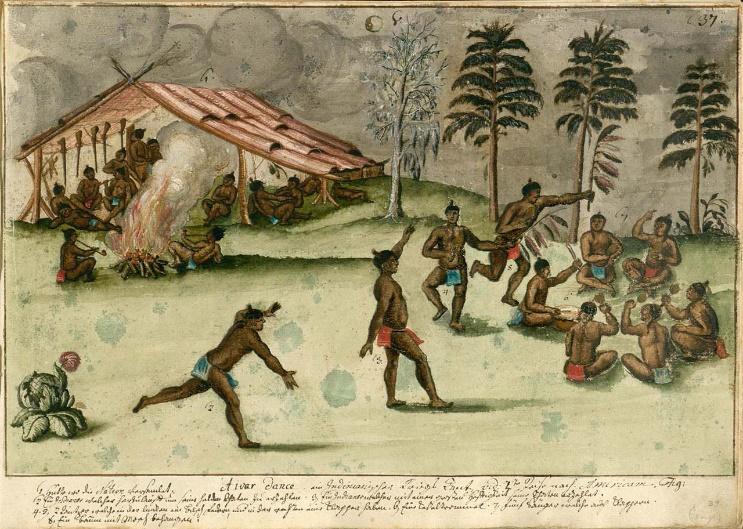6. Oochee Bottom
Dominating Georgia’s colonial period until the 1760s, the Muscogee Nation outnumbered both colonists and enslaved Africans. The Muscogee Nation were a comparatively new and complex political organization known by colonists as the Creek Confederacy. The confederacy included the Yuchi peoples, who are referred to in Marion County as ‘Oochee’.

An Indian War Dance. Philp Georg Friedrich von Reck 1736. Courtesy of National Library of Denmark and Copenhagen University Library.
The Yuchi established a major settlement ‘Euchee Town’ on the Chattahoochee River, nine miles south of present-day Columbus. Well-known allies of the British, they often traded deer hides with coastal colonists. William Bartram visited this community in 1778 and he described it as the largest and most compact Indian community he had ever encountered.
From these large communities smaller Taliwa (daughter) villages would spring. Self-sufficient, numbering between twenty and thirty members, they practiced farming and hunting, returning to the mother community for major celebrations. Marion County hosted one such daughter community located close to the confluence of the Kinchafoonee and Lanahassee Creeks in the southern part of the county. Arrowheads have been found along numerous creeks such as the one that follows along Oochee Bottom. These creeks provided wildlife habitat to support the deerskin trade between the Yuchi and the European colonists. Euchee Town was destroyed in the Creek War of 1813-1814. The Yuchi, along with the rest of the Creek Confederacy, were removed in several waves to Oklahoma, along what has been commonly known as the Trail of Tears.
Submission composed by David Buxton, April 24 2016
References and Further Reading
Hvidt, Kristian, ed. Von Reck’s Voyage: Drawings and Journal of Philip Georg Friedrich von Reck. Savannah, GA: Beehive Press, 1980.
King, Adam, "Mississippian Period: Overview", New Georgia Encyclopedia, 2015, http://www.georgiaencyclopedia.org/articles/history-archaeology/mississippian-period-overview.
Worth, John E, " The Eastern Creek Frontier: History and Archaeology of the Flint River Towns, ca. 1750-1826", UWF.edu, 1997, http://uwf.edu/jworth/worthsaa1997.pdf.
